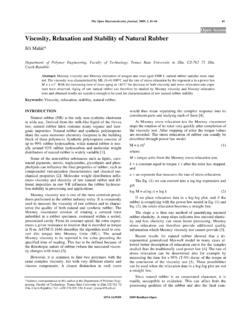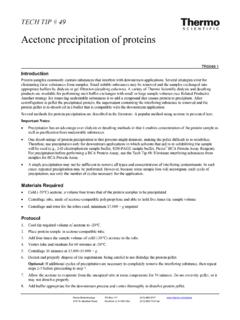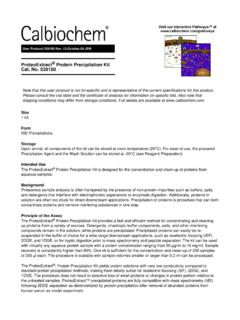Transcription of Comparison of Sample Preparation Methods for the ...
1 20 The Open Proteomics Journal, 2010, 3, 20-25 1875-0397/10 2010 Bentham Open Open Access Comparison of Sample Preparation Methods for the Resolution of Metal-Regulated Proteins in Helianthus Annuus by 2-Dimensional Gel-Electrophoresis Chamari Walliwalagedara1, Harry van Keulen2,*, Teresa Cutright3 and Robert Wei1 1 Department of Chemistry, Cleveland State University, Cleveland, Ohio 44115, USA 2 Department of Biological, Geological, and Environmental Sciences, Cleveland State University, Cleveland, Ohio 44115.
2 USA 3 Department of Civil Engineering, University of Akron, Akron, Ohio 44325, USA Abstract: The Dwarf Sunflower, Helianthus annuus, is a hyperaccumulator of the heavy metals cadmium, nickel, and chromium. The molecular mechanism of hyperaccumulation and adapting to the resulting abiotic stress is largely un-known. Metal-binding and other proteins induced in response to stress conditions may play indispensable roles in allow-ing the metals to accumulate and the plant to adapt itself. However, the presence of large amounts of the large subunit of ribulose1, 5 bisphosphate carboxylase/oxygenase (Rubisco) in leaves hampers the detection of many and, therefore also differentially expressed proteins, in gels. The aim of this study was to improve on Methods of two-dimensional gel elec-trophoresis with high enough resolution for the purpose of identifying differentially expressed proteins for use in liquid chromatography and tandem mass spectroscopy and matrix-assisted laser desorption and ionization time-of-flight mass spectrometric analysis.
3 The Teddy Bear cultivar of H. annuus was exposed to a mixture of cadmium, nickel, chromium, plus lead and lead only. Soluble proteins were extracted from leaf samples and several Sample Preparation procedures were tested. Use of a phenol extraction method enabled better resolution of proteins compared to either acetone or Trichloroacetic acid (TCA/ acetone ) precipitation techniques. TCA/ acetone precipitation combined with a phenol treat-ment step (double precipitation ) improved gel resolution with regard to reducing background staining and horizontal streaks, however, the heavy streaks associated with high concentrations of Rubisco were still present. Treatment of the samples with polyethylene glycol (PEG) was the most effective in reducing these streaks.
4 Keywords: Helianthus annuus, polyethylene glycol, proteomics, 2-DE. INTRODUCTION Contamination of soils and water with heavy metals has become a major environmental issue. Interest in the use of plants for environmental restoration (phytoremediation) has grown following the discovery that some plants are capable of accumulating toxic metals at levels many times greater (hyperaccumulators or hyperacumulator plants) than the non-accumulator plants [1]. Evidence suggests that bio-chemical mechanisms for the hyperaccumulation of heavy metals are complex. We believe that the various proteins that are responding to the plant s exposure to heavy metals could be revealed by a proteomics approach, using two-dimensional gel electrophoresis (2-DE) and mass spectrome-try.
5 In this manner gene expression under different physio-logical conditions, such as environmental stress can be stud-ied. Previously unknown proteins could be involved in metal binding or in general to the plant s response to toxins. Only identification of proteins expressed under defined experi-mental conditions could provide insight in stress response. *Address correspondence to this author at the Harry van Keulen, Depart-ment of Biological, Geological, and Environmental Sciences, Cleveland State University, 2121 Euclid Avenue Cleveland, Ohio 44115. USA; Tel: +1-216-687-4562; E-mail: These proteomics techniques have become the principal means to resolve and characterize proteins in such complex matrices as cellular extracts and serum [2].
6 While the analy-sis of proteins derived from animal and bacterial sources [3] has been the main focus, they have also been applied to a number of plant species including rice [4] and banana [5]. Compared to microorganisms and animal cells, however, the extraction and resolution of proteins from plant tissues pre-sents a number of challenges due to a comparatively low concentration of protein per weight of tissue [6], high prote-ase activities [7, 8], and the presence of various interfering substances, such as polyphenols and carbohydrates [5, 6, 9, 10]. Furthermore, it appears that the protein composition of each plant species is unique. Therefore, a well-defined set of conditions for each plant species is essential in obtaining reproducible and accurate results.
7 In the 1980s, much effort has been directed towards the establishment of Sample prepa-ration Methods for plant tissues [11]. Sample preparations generally use a one-step protocol, , denaturing extraction in lysis buffer, which was shown to be suitable to obtain clean samples [5]. The majority of the protocols for Sample Preparation from plant tissues now involve two or more steps. These are precipitation -based [10] by the addition of high salt concentrations of divalent ions [5] followed by Sample Preparation Methods for protein Resolution on 2-D Gels The Open Proteomics Journal, 2010, Volume 3 21 treatment of water miscible organic solvents such as acetone and acids [9], but a loss of proteins due to either incomplete precipitation or resolubilization of precipitants could present a serious problem.
8 In addition, the electrophoretic separation of proteins from plant extracts is often complicated due to the presence of many non- protein contaminants indigenous to the plant, such as organic acids, lipids, polyphenols, pig-ments, and terpenes [12]. Moreover, a high abundance of certain proteins, , the large subunit of ribulose1,5 bisphosphate carboxylase/oxygenase (Rubisco), can over-shadow the identification of other, less abundant, proteins in 2-DE [13]. The main purpose of this study was to test and optimize Sample Preparation Methods suitable for 2-DE analysis of proteins from H. annuus. MATERIALS AND Methods Plant Materials and Metal Treatments Seeds of the Teddy Bear cultivar of the Dwarf Sunflower (H. annuus) were purchased from the Jung Feed Company (Madison, WI).
9 Seven plants were used in each experiment and were grown and treated with metal ions according to the procedures described previously [14]. Briefly, the plants were exposed to heavy metals in solutions containing a mix-ture of Cd, Cr, Ni (reflecting the contaminated soil condi-tions in Northeast Ohio) plus Pb or Pb alone. In some cases As was used instead of Pb. The metals were applied as Cd2+ ( ), Cr3+ ( ), Ni2+ ( ), Pb2+ (Pb(NO3)2 and As as (Na2 HAsO4) at 30 mg/l for each metal. Seeds of each cultivar were first grown hydroponically in Rockwool, a non-reactive, nonabsorbent support system and sustained with a standard hydroponic nutrient solution (Cropking Corp., Seville, OH). After a four-week growth period, plants were transferred to a PVC trough and sub-jected to the contaminant solution at a complete recycle rate of l/h containing 30 mg/l of the toxins.)
10 After 17 days of exposure, the plants were harvested. Roots, leaves and stems were then sectioned and weighed. All the experiments were repeated twice and the tissues were used for analysis of metal levels and for protein isolation. Extraction of Soluble Proteins from Leaves The plant samples were ground in liquid N2 using a pre-chilled mortar and pestle. The powdered tissue was stored in microcentrifuge tubes ( ml) at 80oC until further use. A protein extraction kit was purchased from G-Biosciences (St. Louis, MO) and the protein extraction buffer was pre-pared by dissolving 1 g of dry protein extraction reagent in ml of the Diluent which makes approximately 2 ml of the protein extraction buffer. Complete Plant Protease Inhibitor cocktail (G-Biosciences) was added (10 l into1 ml protein extraction buffer) and vortexed.



















